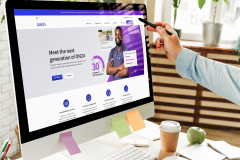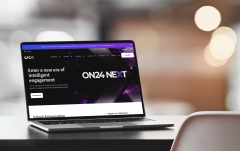How To Create Immersive, Interactive Hybrid Events
- Written by Kelly Lindenau
- Published in Blog
Events are a staple in all industries due to their inherent networking opportunities, educational outlets and, let’s be honest, the exciting end-of-day gatherings. And in the modern world, the hybrid nature of events opens the door to extend those networking and educational opportunities in a way the traditional in-person event can’t. Marketers who fail to leverage the virtual component of events will fall behind their competitors who do.
To learn more about the world of hybrid events and why they’re crucial for marketers to leverage, the Demand Gen Report team sat down with Stacey Fontenot, SVP of Marketing of event technology provider Cvent, to uncover the potential of the virtual medium.
Demand Gen Report: When marketers are planning their events in a hybrid model, what are some of the foundational elements they should consider?
Stacey Fontenot: The first area that comes to mind is making sure you're partnering with the right venue. The venue’s IT backbone and onsite audiovisual expertise will likely be critical to the experience your virtual attendee will have. Increasingly, venues have upped their audiovisual games dramatically to help organizers with the audio, visual and technical components needed to deliver a hybrid event. So, as you are sourcing properties for your hybrid event, make sure to dig deep here during the RFP stage.
The second is the environment into which you deliver that content. Remember, the technology is the venue for your virtual attendees. Choose technologies that deliver content in the many ways your audience wants to experience it, including livestream, simulive and on-demand. Of course, all of this must be done in a secure, high-quality manner and with interactivity features that will keep your audiences engaged.
The third area that's critical to deliver engagement in a hybrid context: Building a sense of community around your event for both your in-person and your virtual attendees. This really is where the “one event and two experiences” approach becomes a reality. One way to do this is to use technology to bridge that gap with interactive elements like polling, live Q&A and chat. These elements can be used by both your in-person elements and virtual attendees to give them a shared experience.
DGR: Speaking of engagement, what are your top tips and tricks for hosting hybrid events to make sure all audiences feel included?
Fontenot: We've done a lot of work in this area, as we’ve hosted two large hybrid conferences ourselves at Cvent. It really comes down to ensuring you're delivering one event with two distinct experiences, because the reality is that your in-person audience and your virtual audience likely have different motivations for attending a hybrid event. But you also have to remember that with hybrid, there is no one-size-fits-all. Every event could, and should, use different levels of digital engagement to meet event goals. Each organization should be purposeful in how it uses virtual and digital elements to extend reach and increase engagement.
DGR: A key benefit of hybrid/virtual events are their inherent longevity — what are some steps marketers can take to extend the life of their events?
Fontenot: Year-round engagement is now a reality for marketing organizations in a way that perhaps it hasn't been. When organizations can extend event engagement before, during and after an event, and use video and on-demand technologies to fill the white space between those events, you're able to stay in front of your prospects, customers and members in an on-brand manner 365 days a year.
Marketers will become orchestrators of a live engagement channel that's highly digital but also capable of delivering more immersive engaging experiences. The channel really is reinventing itself in a way that's very powerful for marketing organizations.
DGR: With that in mind, how do you envision the virtual event landscape reinventing itself in the next couple years?
Fontenot: It's a very exciting time. Over the next couple of years, we see companies continuing to enhance virtual event production values while at the same time focusing on ease of use to truly enable rapid development of high-quality virtual event experiences and webinars. We do believe virtual events will move from multi-day, multi-session occurrences to single-day, multi-hour events, but with far higher levels of production quality and interactivity.
Related items
-
 ON24 Unveils The Next Generation Of Its Intelligence Platform
ON24 Unveils The Next Generation Of Its Intelligence Platform
-
 Vendelux Aims To Streamline Event Marketing With AI-Powered Intelligence Platform
Vendelux Aims To Streamline Event Marketing With AI-Powered Intelligence Platform
-
 Cvent Acquires Jifflenow & iCapture To Expand Trade Show & Conference Offerings
Cvent Acquires Jifflenow & iCapture To Expand Trade Show & Conference Offerings
-
 ON24 To Reveal AI Innovations During Platform Launch Event
ON24 To Reveal AI Innovations During Platform Launch Event
-
 AI-Powered Event Platform Vendelux Raises $14M In Series A Funding
AI-Powered Event Platform Vendelux Raises $14M In Series A Funding




